Siluro FX 5600 DT 256MB
Two cards from ABIT, and both cards based on the same GPU. Sounds like it's going to be a boring review, doesn't it ?. However, once we start digging a little deeper into each card's specifications, we'll see that these are radically different. Let's have a look at the 256MB model first.
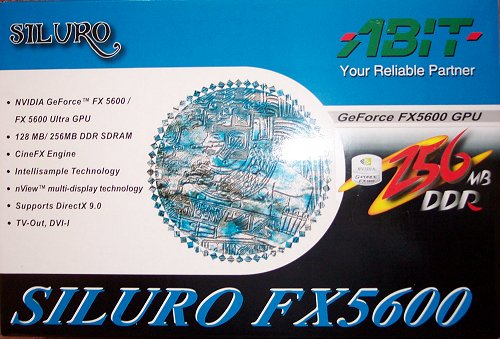
Pertinent points are listed on the left-hand side. Please note that there's distinct speed differences between the FX 5600 and FX 5600 Ultra. Further, one can even differentiate the FX 5600 Ultra from the FX 5600 Ultra Rev. 2. We'll clear up any confusion before we begin benchmarking. Again, to bewilder the consumer that little bit more, NVIDIA gives manufacturers the opportunity of configuring their cards in either 128MB or 256MB forms. Given the number of different combinations of GPUs and memory sizes, the buyer needs to know exactly what they're getting for their cash.
The sample card is a 256MB model; a number that's sure to wow the graphically uneducated. Will 256MB of on-board RAM really lead to meaningful gains on a midrange card ?. That's another of the questions we'll be answering a little later. Suffice to say that this is a GeForce FX 5600 with 256MB of on-board RAM. The twist is in the speeds of the GPU and memory. Read on.
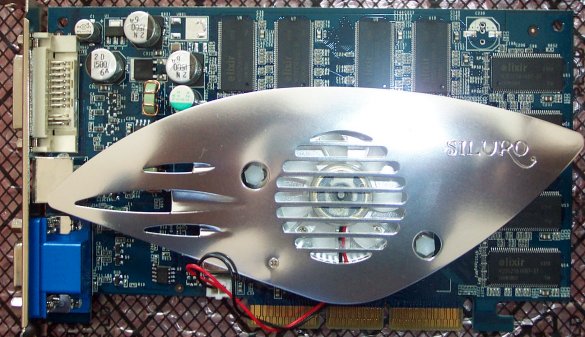
An impressive-looking, eye-shaped heatsink dominates the centre of the card. On first glance, it seems to be a substantial aluminium block but remove the eye-shaped piece, through two small screws that fasten into the smaller heasink underneath, and the guts of the cooling is revealed. We wonder just how much real benefit the large aluminium eye confers. More a case of aesthetics over purpose, probably.

If ABIT had left just the basic cooler on without the aluminium appendage, many potential buyers would have been a little unimpressed. Held on firmly by two push-through pins, it more than good enough at cooling the 325MHz 0.13-micron NV31 GPU underneath. As a little nod towards enthusiasts, the card emits a pleasing blue glow when running. It'll add a little class to those who have windowed cases. The fan is barely noticeable above the general noise of any modern PC. A definite candidate of the quietest GPU fan of '03. The 325MHz GPU speed is a talking point in itself, but the memory speed is even more crucial. Why ?. Here's why.
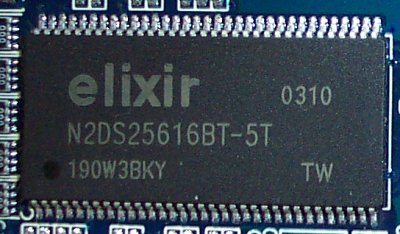
What we have here, folks, is a 256 Mbit chip from elixir. Multiply that by 8, the number of chips on the topside, and we arrive at the quoted 256MB figure. Two further interesting facts are that a) it' still TSOP RAM on a GPU that traditionally carries Tiny BGA RAM and b) it's 5ns RAM (200MHz, DDR400). That's the single most important factor on this card. We, at HEXUS, reviewed a 128MB GeForce FX 5600 Ultra Rev. 2. That card, a reference model from NVIDIA, carried speeds of 400MHz GPU and 800MHz RAM. This 256MB model, which still comes under the umbrella FX 5600 naming scheme, has 75MHz less core speed and a whopping 400MHz less memory speed; effectively half the bandwidth of the Ultra Rev. 2. It's bemusing as to why ABIT would wish to strap on such antiquated memory on a modern, midrange card. I guess 256MB of DDR400 TSOP RAM is pretty inexpensive, and a card with 256MB of RAM would sell to the uneducated.
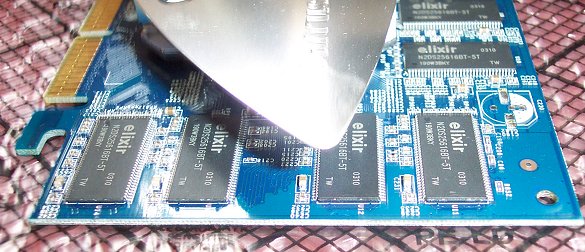
The low power requirement of a 325MHz core, running from a 0.13-micron manufacturing process, negates the need for an auxillary power connector. ABIT has further attempted to reduce costs by not specifying any passive RAM cooling. Hardly necessary for 400MHz memory, though.

NVIDIA's standard connectivity layout on the back. DVI-I on the left, TV-Out in the middle and HD15 on the right. That's directly opposed to ATi's 9600 / PRO layout. In terms of specification, the dual 400MHz RAMDACs afford an exotic 2048x1536x32 @ 85Hz, the DVI-I is limited to 1600x1200x32 and the TV-Out function can output to 1024x768. Note that there is no video-in facility on this card. However, NVIDIA's TV-Out quality has improved markedly over time. Add to that the slick dual display functionality inherent in the newer Detonator drivers sets and you have a decent all-around package. Speaking of packages.
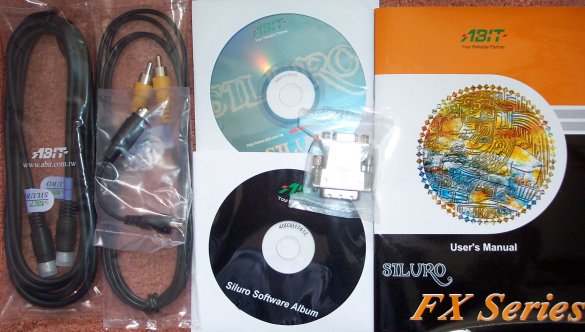
ABIT's Siluro bundles have always been either just above or just below average. THE OTES bundles have often included a few unexpected extras, but the standard Siluro's is a case of a manufacturer providing just enough hardware and software to get going. A multi-language manual that seems to cover a number of different Siluro FX-based cards is a little brief for our liking. A few pages is all that's needed to cover everything one needs to know about the card, ABIT reckons. ABIT always does well with cabling, and the ABIT-branded RCA and S-Video extension cables are a nice, neat touch. A S-Video-to-RCA converter and DVI-to-VGA dongle complete the hardware side of things. Software-wise, there's a demo of Soldier of Fortune II, Earthviewer 3D Demo, WindowsBlinds NVIDIA edition, a rebadged version of WinDVD 4 with a few interesting features tacked on. More pertinent to this card, however, is the driver CD with ABIT's drivers and overclocking software. We'll come back to that later.









